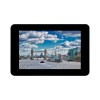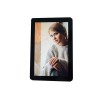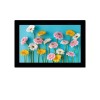Products
Hot Product
7 inch Capacitive Touch Screen USB with anti glare cover glass for Medical Instrument
7.0 inch Project Capacitive Touch Panel
CTP Model: RTPB70542A0
Touch Panel Size: 7.0inch
Touch Panel Interface: USB
Touch IC: ILITEK2511
TouchGlass Colour: optional black or white
Oprating Temp.( ℃): -20~+70
Storage Temp.(℃): -30~+80
7.0inch touch panel screen for LCD module parameters
|
Item |
Specification |
Unit |
|
Touch panel size |
7.0 |
inch |
|
Touch Module Outline |
164.5(W) ×99.6(H) ×1.85(T) |
|
|
Viewing Area |
154.88(W)×86.72(H) |
mm |
|
Touch panel Type |
Project Capcitive touch screen |
|
|
Touch IC |
ILI2511 |
-- |
|
Touch point |
Multi-point |
-- |
|
Touch structure |
Glass+OCA+Glass |
-- |
|
Touch Interface |
USB |
-- |
|
Cover lens |
GLASS |
mm |
|
Cover lensColors |
Black/White |
-- |
|
Surface hardness |
≧6H |
-- |
|
Weight (LCM/TP+LCM) |
/ |
kg |
|
Operating Temperature |
-20℃~ +70℃ |
Deg.c |
|
Storage Temperature |
-30℃~ +80℃ |
Deg.c |
What is the difference between IPS and capacitive touch screen?
IPS (In-Plane Switching) and capacitive touch screens refer to different aspects of display technology and touch sensitivity. Here’s a breakdown of their differences:
IPS (In-Plane Switching)
1. Type of Technology: IPS is a type of LCD (Liquid Crystal Display) technology used primarily for improving viewing angles and color accuracy.2. Characteristics:
- Wide Viewing Angles: IPS panels provide consistent color and brightness, even when viewed from wide angles.
- Color Accuracy: They typically offer better color reproduction compared to other LCD types (like TN or VA panels).
- Response Time: Generally good response times, making them suitable for dynamic content.
3. Use Cases: IPS technology is common in high-end monitors, tablets, and smartphones where color quality and viewing experience are important.
Capacitive Touch Screen
1. Type of Technology: Capacitive touch screens use the electrical properties of the human body to detect touch.2. Characteristics:
- Touch Sensitivity: They respond to finger touches and can detect multiple touch points (multi-touch). They generally do not work with non-conductive objects like gloves unless they are specially designed.
- Better Durability: Typically have a more durable surface and can be more responsive than resistive touch screens.
- Multi-Touch Capabilities: Support gestures like pinch-to-zoom and swipe due to their ability to track multiple touch points simultaneously.
3. Use Cases: Common in smartphones, tablets, and other devices that require user interaction.
Summary
- Functionality: IPS refers to the technology used for the display screen itself, providing better visuals, while capacitive refers to how the screen detects touch.- Compatibility: An IPS display can be a part of a capacitive touch screen setup, meaning you can have an IPS-capacitive touch screen combo that offers both superior display quality and touch sensitivity.
Understanding these differences helps in choosing the right device based on visual quality and user interaction preferences.













